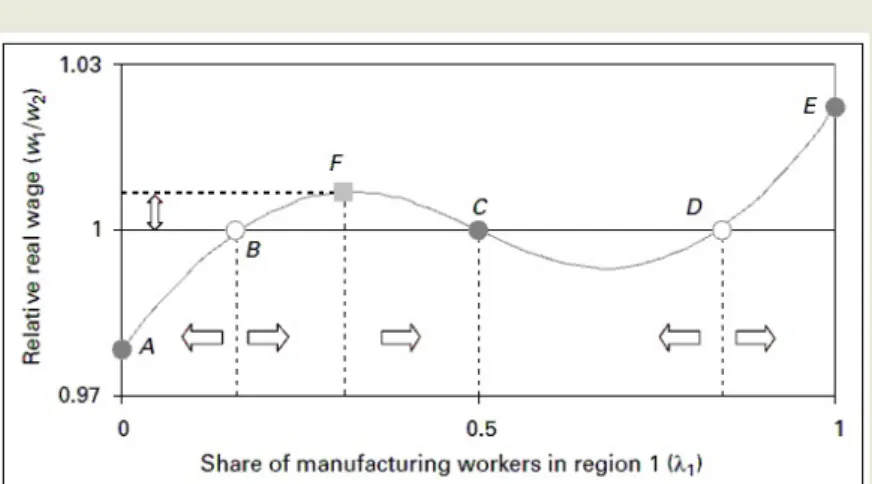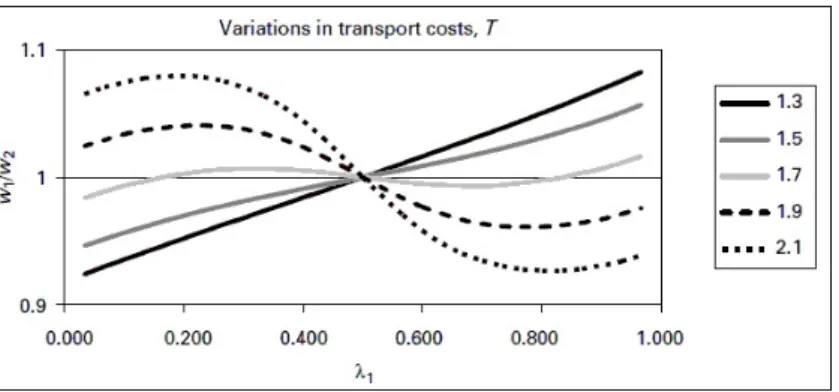GEOGRAPHICAL ECONOMICS
ELTE Faculty of Social Sciences, Department of Economics
Geographical Economics
week 8
KRUGMAN (1991) MODEL: DYNAMICS AND SIMULATION Author: Gábor Békés, Sarolta Rózsás
Supervised by Gábor Békés
June 2011
week 8 Gábor Békés
Krugman model 2:
dynamics Equilibrium and simulations Equilibrium Results and history
Outline
1 Krugman model 2: dynamics Equilibrium and simulations Equilibrium
Results and history
week 8 Gábor Békés
Krugman model 2:
dynamics Equilibrium and simulations Equilibrium Results and history
Equilibrium
Krugman (1991) model - continuation Dynamics, equilibrium
BGM Chapter 4.2-4.4 BGM Chapter 4.5 in part
Krugman's slogan: geographical economics model =
1 Dixit-Stiglitz core
2 + icebergs
3 + evolution
4 + a computer
week 8 Gábor Békés
Krugman model 2:
dynamics Equilibrium and simulations Equilibrium Results and history
Equilibrium
Very dicult, non-linear model
How can we calculate an equilibrium for a given distribution ofλ?
1 Determining the exogenous parameters
2 and using a computer for simulations. . .
week 8 Gábor Békés
Krugman model 2:
dynamics Equilibrium and simulations Equilibrium Results and history
The model
The model, if φ1 =φ2=0.5
Y1 =λ1W1δ+0.5(1−δ);Y2=λ2W2δ+0.5(1−δ) (1) I1= (λ1W11−e+λ2W21−eT1−e)1/(1−e); (2) I2= (λ1T1−eW11−e+λ2W21−e)1/(1−e) (3)
W1 = [Y1I1e−1+Y2T1−eI2e−1]1/e; (4) W2 = [Y1T1−eI1e−1+Y2I2e−1]1/e (5)
w1 =W1I1−δ;w2 =W2I2−δ (6)
week 8 Gábor Békés
Krugman model 2:
dynamics Equilibrium and simulations Equilibrium Results and history
Parameters
How should we choose the values of parameters for the simulation?
Empirical observations Round numbers Usefulness. . . δ=0.4
L=1
λ1+λ2=1 φ1=φ2=0.5 e=5
ρ=1−1/5=0.8 1/(1−e) =−0.25 T =1.7
T1−e=0,12
week 8 Gábor Békés
Krugman model 2:
dynamics Equilibrium and simulations Equilibrium Results and history
The model
After normalization and simplications
Y1=0.4λ1W1+0.3;Y2 =0.4λ2W2δ+0.3 (7) I1= (λ1W1−4+0,12λ2W2−4)−0.25; (8) I2= (0,12λ1W1−4+λ2W2−4)−0,25 (9)
W1 = [Y1I14+0,12Y2I4)0,25; (10) W2 = [0,12Y1I14+Y2I24]0,25 (11)
w1=W1I1−0,4;w2 =W2I2−0,4 (12)
week 8 Gábor Békés
Krugman model 2:
dynamics Equilibrium and simulations Equilibrium Results and history
Procedure
Sequential iteration
Denition: W1,5:=the value of W1after the fth iteration (it)
Guess an initial solution for the wage rate in the two regions (W1,0=W2,0=1), where 0 indicates the number of iterations
Calculate the income levels (Y1,0Y2,0) and price indices (I1,0
I2,0)
Substitute and determine a new possible solution for the wage rates (W1,1,W2,1)
Repeat these steps until a solution is found: when W barely changes
(Wr,it−Wr,it−1)/Wr,it−1<σ, for each r =1,2 σ:=0.0001
week 8 Gábor Békés
Krugman model 2:
dynamics Equilibrium and simulations Equilibrium Results and history
Relative real wage
Real wages are the incentive to move
When we get the short-run equilibrium setting (I,Y,W ) ⇒ we can calculate the ratio w1/w2
Figure on real wages
Simulations - x a given value ofλ1and seek the equilibrium values of variables to this
Execute this program several times, varyingλ1between zero and one
Plotting the relative real wage in region 1 against the value of λ1
Equilibrium, if
w1/w2=1 and 0<λ1<1 or complete agglomeration (λ1=1 or 0)
week 8 Gábor Békés
Krugman model 2:
dynamics Equilibrium and simulations Equilibrium Results and history
Figure on the relative real wage
week 8 Gábor Békés
Krugman model 2:
dynamics Equilibrium and simulations Equilibrium Results and history
Figure on the relative real wage (2)
There are three types of equilibrium
A,E - complete agglomeration of manufacturing production C - spreading of manufacturing production over the two regions
B,D - manufacturing production is partially agglomerated Total of ve long-run equilibria
3 equilibria `nding' them analytically (guessing) (A,E,C) 2 equilibria nding them with simulations (B,D)
week 8 Gábor Békés
Krugman model 2:
dynamics Equilibrium and simulations Equilibrium Results and history
Stability
Stability (on the basis of w1/w2)
Suppose, e.g., that we are in point F ; w1 is greater than w2, therefore it is worth moving to R1 (λ1increases), and get to point C.
It is valid for any arbitrary point between points B and C When the economy is located somewhere between point B and D, it reaches the spreading equilibrium sooner or later.
This point is the basin of attraction for the spreading equilibrium.
Similar reasonings hold for the segments between points A and B and between points D and E. They are called the basin of attraction for the agglomeration equilibrium.
week 8 Gábor Békés
Krugman model 2:
dynamics Equilibrium and simulations Equilibrium Results and history
Instability of equilibria
There are two points (B and D), that are equilibria, but unstable.
If the economy `falls' exactly in these points, it will stay there (real wages are equal)
Any arbitrarily small perturbation of this equilibrium will set in motion a process of adjustment. . .
week 8 Gábor Békés
Krugman model 2:
dynamics Equilibrium and simulations Equilibrium Results and history
Figure on transport costs
week 8 Gábor Békés
Krugman model 2:
dynamics Equilibrium and simulations Equilibrium Results and history
The eect of transport costs
Recall: transport (transaction) costs are the `heart' of the model, the most important exogenous factor
Repeating the previous procedure for T ={1.3,1.5,1.7,1.9,2.1}
If transport costs are large (T =1.9 or T =2.1), the spreading equilibrium is the globally (unique) stable equilibrium
When the two regions are too far away from each other, it is not worth producing in either of them and shipping to the other.
If transport costs are smaller (T =1.3 or T =1.5), the agglomerating equilibria are stable
If the two regions are very close to each other, the one that has a production cost-advantage (lower wage), will be the
`winner' (complete agglomeration).
The spreading equilibrium exists but unstable!
T =1.7 - there exist more equilibria. How special is this settings?
Not so frequent
But it always exists (for each parameter setting can be assigned a particular T )
week 8 Gábor Békés
Krugman model 2:
dynamics Equilibrium and simulations Equilibrium Results and history
Figure on transport costs
week 8 Gábor Békés
Krugman model 2:
dynamics Equilibrium and simulations Equilibrium Results and history
The eect of changes in transport costs
Put the equilibrium distribution of mobile workforce λon the vertical axis and transport costs T along the horizontal axis S sustain point - until which complete agglomerations are equilibria
B break point - from which the spreading is equilibrium The segment between points B and S may be arbitrarily small or even a point.
>The tomahawk diagram
week 8 Gábor Békés
Krugman model 2:
dynamics Equilibrium and simulations Equilibrium Results and history
The `tomahawk' diagram (a)
week 8 Gábor Békés
Krugman model 2:
dynamics Equilibrium and simulations Equilibrium Results and history
Agglomeration equilibrium (Reminder)
All manufacturing workers are located in one of the regions.
Agglomeration in region 1 (λ1=1,λ2 =0) W1 =1
Then I1=1,I2=T
and Y1= (1+δ)/2,Y2= (1−δ)/2 W1 =1,w1 =1
W2 =[(1+δ)/2]T1−e+ (1−δ)/2]Te−1 1/e w2e = [(1+δ)/2]T1−e−eδ+ (1−δ)/2]Te−1−eδ
If T is nor too large (but T >1), w2<1, i.e. nobody wants to move
week 8 Gábor Békés
Krugman model 2:
dynamics Equilibrium and simulations Equilibrium Results and history
Sustain point (S)
What does the assumption `T is not too large' mean? We can determine a sustain point (S):
w2e =f(T) = [(1+δ)/2]T1−e−eδ+ (1−δ)/2]Te−1−eδ=1
⇒S(T)'1.81
week 8 Gábor Békés
Krugman model 2:
dynamics Equilibrium and simulations Equilibrium Results and history
Sustain point (S)
What does the assumption `T is not too large' mean? We can determine a sustain point (S):
w2e =f(T) = [(1+δ)/2]T1−e−eδ+ (1−δ)/2]Te−1−eδ=1
⇒T '1.81
As transport costs increase, however, the rst term in the above equation becomes arbitrarily small, while the second term becomes arbitrarily large if
1−e−eδ>0⇒1−e>eδ⇒(1−e)/e>δ⇒ρ>δ ρ>δ= no-black-hole condition if this condition is not fullled the forces working toward agglomeration would always prevail (independently from transport costs), and the economy would tend to collapse into a point.
week 8 Gábor Békés
Krugman model 2:
dynamics Equilibrium and simulations Equilibrium Results and history
Symmetry break point (B)
Break point (B) - from which the spreading equilibrium is stable
Recall: Ha W1=W2=1
Then I1=I2= (0.5)1/(1−e)(1+T1−e)1/(1−e) and Y1=Y2=0.5
W1 =1=W2,és w1 =w2 : this is an equilibrium We can show, that the condition necessary to break the spreading equilibrium, i.e., dw/dλ>0
g(T):= 1−T1−e
1+T1−e + [1−δ(1+ρ)
δ2+ρ ]<1 (13) The rst term on the right-hand side is Z ∈(0,1) and is monotonically increasing in transport costs T, while the second term is a constant fraction strictly in between zero and one (if the no-black-hole condition is fullled). See the gure above!
Now B(T)'1.63
week 8 Gábor Békés
Krugman model 2:
dynamics Equilibrium and simulations Equilibrium Results and history
Krugman-Fujita-Venables (1999) Theorem
Theorem
Suppose the no-black-hole condition (ρ>δ) holds in a symmetric two-region setting of the Krugman model, then (i) complete agglomeration of manufacturing activity is not sustainable for suciently large transport costs T, and (ii) spreading is a stable equilibrium for suciently large transport costs T.
week 8 Gábor Békés
Krugman model 2:
dynamics Equilibrium and simulations Equilibrium Results and history
History matters! (1)
An important implication of the model
Case A: Transport costs are large, e.g., T =2.5, and the spreading equilibrium is stable
Suppose that transport costs start to fall, T =1.7 - as B(T)=1.63, the spreading equilibrium remains stable Case B: Transport costs are large, e.g., T =1.3, then agglomeration equilibrium is established in one of the two regions
Suppose that transport costs start to rise, T =1.7 - as S(T)=1.81, nothing happens. Agglomeration of manufacturing activity remains a stable equilibrium That is, in the case of T =1.7, the outcome equilibrium depends on history.
= "Evolution"
week 8 Gábor Békés
Krugman model 2:
dynamics Equilibrium and simulations Equilibrium Results and history
History matters! (2)
Go back to the `tomahawk' diagram. Suppose that transport costs are large and we begin to reduce them (e.g.
technological progress).
week 8 Gábor Békés
Krugman model 2:
dynamics Equilibrium and simulations Equilibrium Results and history
History matters! (2a)
Go back to the `tomahawk' diagram. Suppose that transport costs are large and we begin to reduce them (e.g.
technological progress).
Until a particular point there is symmetry, then the economy sharply renders to agglomeration
Recall: Letη be the speed of adjustment and w is the weighted average of the real wages (w =λ1w1+λ2w2). Then the motion of manufacturing labor can be described by this simple dynamic system: dλλ11 =η(w1−w)
Which of the regions?
The one to which the rst migrant decides to move or the outcome is solely the result of a historical accident Non-linear relationship!
Due to a small step the economy suddenly reaches one of the agglomeration equilibria
T falls until a particular point nothing happens T falls further sudden powerful change


